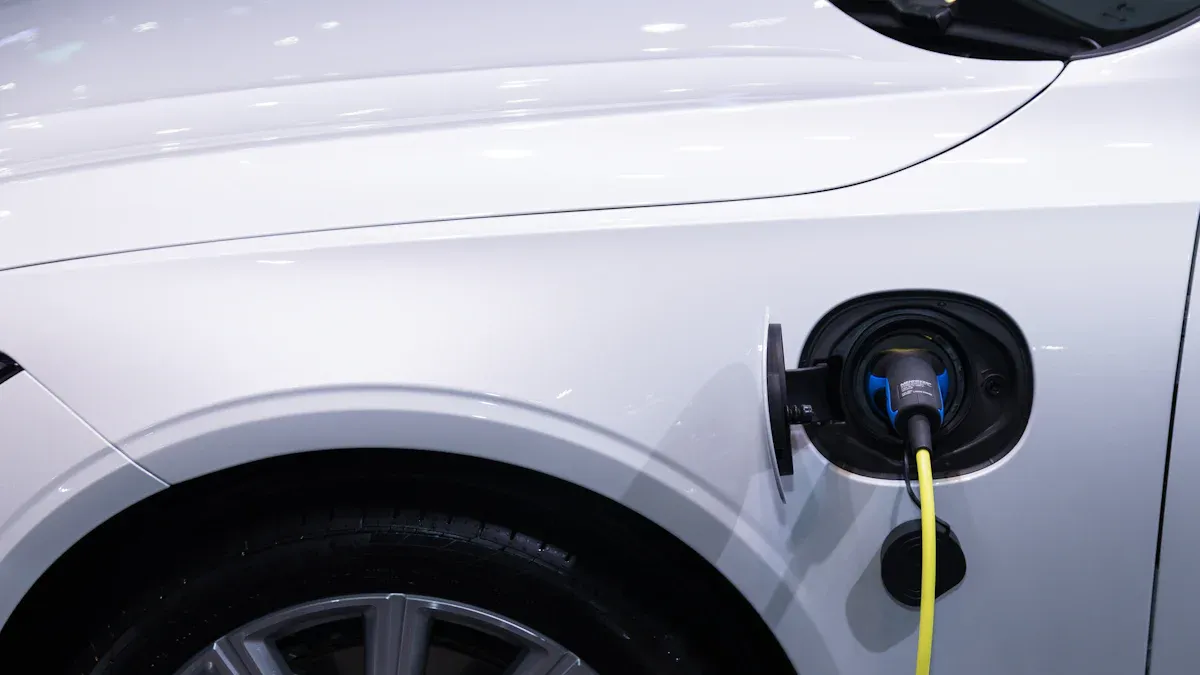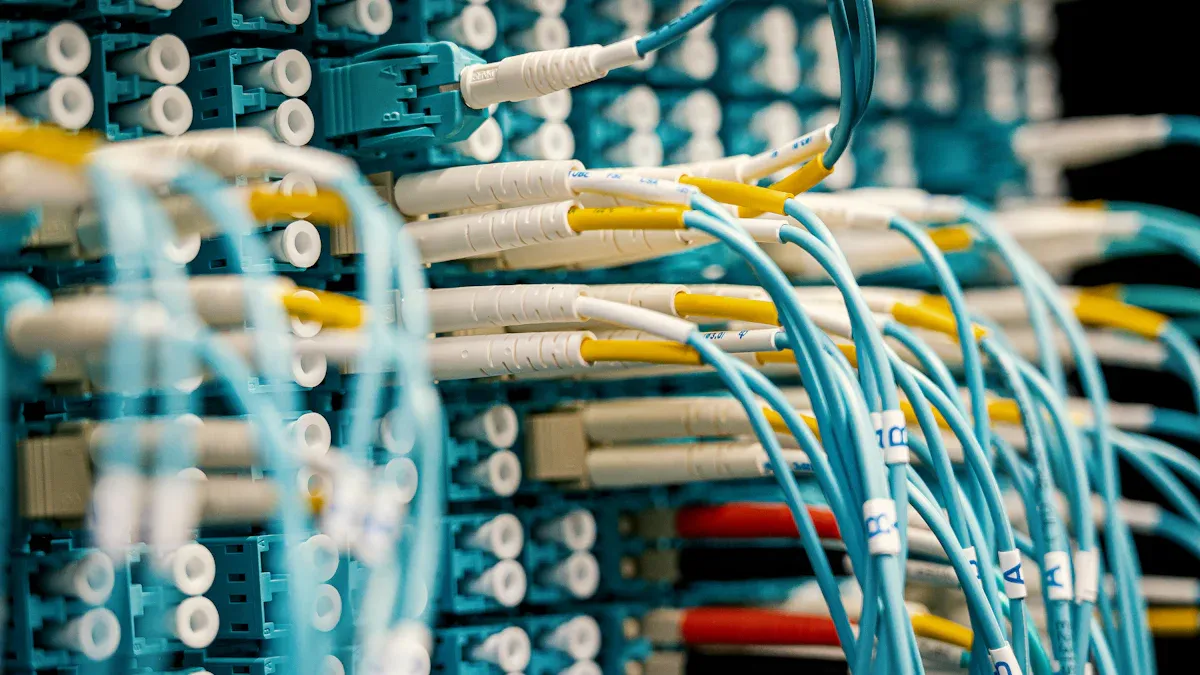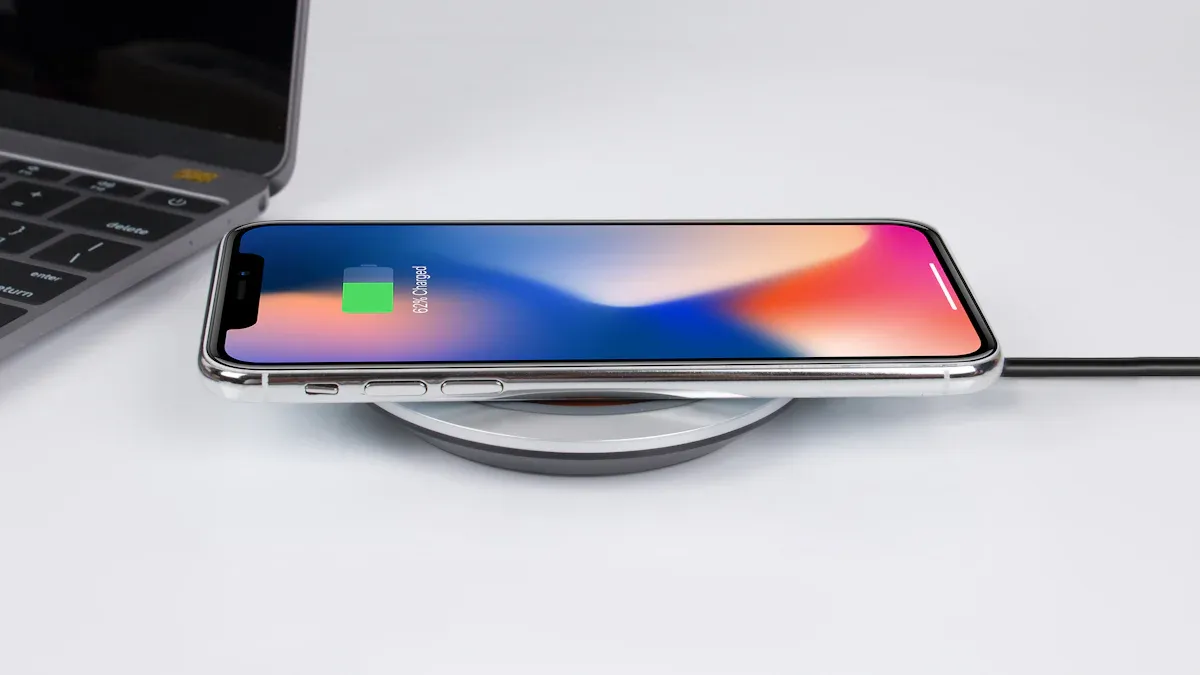The demand for efficient and sustainable charging solutions has surged, transforming how you power devices. Custom cable manufacturing plays a crucial role in meeting this demand. Recent trends highlight significant growth in this sector:
- The power and control cable market is set to reach USD 150,680.3 million by 2025, with a projected CAGR of 7.3% through 2035.
- Heavy-duty EV charging infrastructure is expected to grow from USD 2,865.4 million in 2023 to USD 14,859.1 million by 2033, reflecting an 18.1% CAGR.
These advancements pave the way for a universal charging experience while promoting sustainability and innovation.
USB-C as the Universal Standard
USB-C’s widespread adoption across industries
USB-C has become the go-to standard for modern devices. Its versatility and performance have driven its adoption across industries. For example:
– Apple’s decision to include USB-C in the iPhone 15 marks a significant shift in consumer electronics.
– USB-C supports high-speed data transfer, 4K video, and enhanced power delivery, making it ideal for both personal and professional use.
– Industry experts predict USB-C will dominate residential and commercial AV setups, offering seamless connectivity.
The demand for USB-C charging cables continues to grow as more devices integrate USB-C ports. This trend reflects the increasing need for faster data transfer and reliable charging solutions. The USB-C interface also supports USB 3.0 technology, which enhances connectivity and performance. These advancements make USB-C a universal solution for various applications.
Benefits for custom cable manufacturing
The rise of USB-C has opened new opportunities for custom cable manufacturing. USB-C charging cables offer several performance benefits:
| Metric | Description |
|---|---|
| Data Transfer Speeds | USB Type-C supports USB 3.1 and USB 3.2 standards, achieving speeds up to 20Gbps or higher with Thunderbolt technology. |
| Power Delivery Capabilities | Supports power outputs from 18W to 240W, enabling faster charging and powering larger devices. |
| Audio and Video Support | Capable of transmitting high-quality video and audio signals, including 4K 60Hz and 8K 60Hz. |
| Peripheral Support | Allows connectivity with various peripherals, reducing the need for multiple cables and adapters. |
These features make USB-C charging cables a preferred choice for manufacturers. Custom USB cable assemblies can now cater to diverse needs, from high-speed data transfer to powering large devices. This flexibility allows manufacturers to meet market trends while delivering innovative solutions.
Overcoming challenges in transitioning to USB-C
Transitioning to USB-C comes with challenges. Manufacturers must adapt to new standards and invest in updated production processes. The shift requires retooling factories to accommodate USB cable assembly for USB-C ports. Additionally, ensuring compatibility with legacy devices remains a concern.
However, these challenges present opportunities for growth. By embracing USB-C adoption, manufacturers can align with market trends and consumer demands. The universal nature of USB-C simplifies connectivity, reducing the need for multiple chargers and cables. This shift not only benefits consumers but also promotes sustainability by minimizing electronic waste.
Innovations in USB Power Delivery
GaN technology and its impact on charging
Gallium Nitride (GaN) technology has revolutionized charging technology by offering smaller, more efficient chargers. Unlike traditional silicon-based chargers, GaN chargers operate at cooler temperatures and deliver higher power in a compact design. This advancement allows you to enjoy faster charging without bulky adapters.
Key benefits of GaN technology include:
– Compact size: GaN chargers are significantly smaller, making them ideal for portability.
– Improved efficiency: They reduce energy loss, ensuring more power reaches your devices.
– Cooler operation: Lower heat generation enhances safety and durability.
For custom cable manufacturing, GaN technology opens doors to innovative designs. By combining GaN chargers with high-quality cables, manufacturers can create solutions that maximize charging efficiency and user convenience.
| Measurement | Impact on Charging Speed and Efficiency |
|---|---|
| Cable Gauge | Lower AWG (thicker wire) reduces resistance, leading to better conductivity and less heat generation. |
| Cable Length | Recommended length of 1m minimizes resistance, enhancing power delivery and efficiency. |
| Material Quality | High-quality materials reduce resistance and heat, improving overall performance. |
High-power EPR and its applications
Extended Power Range (EPR) modes, introduced in USB PD Revision 3.1, have expanded the capabilities of USB power delivery. These modes support power levels up to 240W, enabling you to charge high-demand devices like laptops and even some EV charging cables.
EPR cables come with specific requirements:
– They must include cable E-markers and meet a minimum voltage of 53.65V.
– They are rated at either 60W or 240W, ensuring compatibility with modern devices.
– Safety features like arcing mitigation and bypass capacitors rated at 63V are mandatory.
This charging technology ensures faster and safer power delivery for a wide range of applications. Whether you’re charging a smartphone or a high-performance laptop, EPR cables provide the reliability and efficiency you need.
Implications for custom cable design
USB power delivery innovations have transformed the way custom cables are designed. Higher power levels, faster charging, and improved compatibility are now standard expectations. For example, USB PD supports up to 240W, allowing you to charge both low-power devices and high-demand electronics efficiently.
Custom cable manufacturers must adapt to these advancements by focusing on:
– Power delivery capabilities: Ensuring cables can handle up to 240W for rapid charging.
– Data transfer rates: Supporting speeds up to 10 Gbps with USB 3.2 and higher.
– Environmental sustainability: Reducing the need for multiple chargers by creating versatile, high-performance cables.
These innovations not only meet the demands of modern devices but also promote sustainability. By minimizing the need for multiple chargers, USB power delivery contributes to reducing electronic waste.
| Performance Indicator | Implication |
|---|---|
| Power Delivery Capabilities | Supports up to 240W, allowing for rapid charging and versatility in device applications. |
| Data Transfer Rates | Can reach up to 10 Gbps with USB 3.2 and higher, enhancing data transfer efficiency. |
| Compatibility with Standards | Adapts to existing standards, ensuring broad usability across devices and reducing charger clutter. |
USB power delivery innovations have set a new benchmark for charging technologies. As these advancements continue, you can expect even more efficient and sustainable solutions in the future.
Eco-Friendly Trends in Custom Cable Manufacturing
Recyclable and biodegradable materials
The shift toward recyclable and biodegradable materials is transforming custom cable manufacturing. Companies now use bioplastics and recycled metals to reduce their carbon footprint. These materials align with circular economy principles, ensuring minimal waste. For example, biodegradable insulation and recyclable components are becoming standard in cable assembly production. This approach not only supports sustainability but also complies with stricter regulations on waste management and emissions.
| Eco-Friendly Practices | Benefits |
|---|---|
| Biodegradable Insulation | Reduces environmental impact by breaking down naturally after disposal. |
| Recycled Metals | Lowers the demand for raw materials, conserving natural resources. |
| Bioplastics | Offers a renewable alternative to traditional plastics. |
By adopting these materials, manufacturers can reduce operational costs by up to 30%. This makes eco-friendly practices both sustainable and financially beneficial.
Reducing e-waste through innovative designs
Innovative designs play a crucial role in reducing e-waste. Custom cable manufacturing now focuses on creating durable and reusable cables. For instance, cables designed for USB chargers often feature modular components. These allow you to replace damaged parts instead of discarding the entire cable. This approach extends the product’s lifespan and minimizes waste.
The rise of efficient charging solutions also contributes to e-waste reduction. High-quality cables paired with advanced chargers ensure optimal performance, reducing the need for frequent replacements. As a result, you can enjoy reliable device charging while contributing to a cleaner environment.
Meeting consumer demand for sustainability
Consumer demand for sustainability is driving growth in the cable industry. Many homeowners and investors now prefer eco-friendly solutions for home charging solutions and other infrastructure needs. The construction sector, in particular, emphasizes sustainable wires and cables to meet energy efficiency standards. These materials are essential for creating green buildings and energy-efficient data centers.
Major companies are also prioritizing sustainable practices. By integrating eco-friendly cables into their charging infrastructure, they reduce their carbon footprint. This trend reflects a broader shift toward efficient charging and sustainable growth. As a consumer, you benefit from these advancements through improved performance and a reduced environmental impact.
Smart Features in Charging Cables
Real-time performance monitoring
Smart charging cables now include real-time performance monitoring to ensure optimal functionality. These cables continuously track their performance, identifying potential issues before they escalate. For instance, advanced systems can monitor partial-discharge activity, which helps detect weak spots in the cable. This proactive approach minimizes downtime and enhances reliability.
| Feature/Capability | Description |
|---|---|
| Continuous Monitoring | Enables around-the-clock surveillance of partial-discharge activity, identifying weak spots in real-time. |
| Precise Fault Location | Pinpoints the location of failures within 1% of circuit length, significantly reducing repair time. |
| Proactive Maintenance Strategies | Optimizes maintenance by focusing resources on cables needing repair or replacement. |
| Monitoring Range | Capable of monitoring up to 6 miles of XLPE insulated cable and 2.5 miles of PILC cable under typical conditions. |
These features ensure that your charging cables remain efficient and safe, reducing the risk of unexpected failures.
AI-driven diagnostics for predictive maintenance
Artificial intelligence has transformed how you maintain charging cables. AI-driven diagnostics analyze data to predict potential failures, allowing you to address issues before they occur. Different models offer varying levels of accuracy in fault detection:
| Model | Accuracy in Fault Detection | Notes |
|---|---|---|
| Logistic Regression | Moderate | Simple and interpretable, suitable for quick decisions. |
| SVM | High | Effective for multi-class classification and managing non-linear relationships. |
| Catboost | Highest | Exceptional accuracy, particularly with large and imbalanced datasets. |
By integrating these models, manufacturers can create smarter cables that last longer and perform better. Predictive maintenance not only saves time but also reduces costs associated with unexpected repairs.
Enhancing user experience with intelligent features
Intelligent features in charging cables enhance your overall experience. These innovations focus on safety, efficiency, and convenience. For example:
– Adaptive charging adjusts the speed based on your device’s capacity and battery level, ensuring fast yet safe charging.
– Temperature control regulates power output to prevent overheating, protecting your device’s battery.
– Energy efficiency features, like auto-off, stop the charger from drawing power once your device is fully charged.
These features make charging more reliable and eco-friendly. You can enjoy faster charging without worrying about damaging your devices or wasting energy. As technology advances, these intelligent features will become standard in most USB charging cables, offering you a seamless and efficient experience.
Lightweight and Flexible Cable Designs
Portability and modern design priorities
Portability has become a top priority for consumers when selecting charging cables. You likely prefer cables that are lightweight and easy to carry, especially for travel or daily use. Modern designs now focus on multi-functional cables that can charge multiple devices, reducing the need for extra accessories. This trend aligns with the growing popularity of USB-C technology, which simplifies connectivity and enhances convenience.
Durability also plays a significant role in modern cable design. Materials like braided nylon are increasingly favored for their ability to withstand wear and tear. Eco-friendly materials are gaining traction as well, reflecting the preferences of environmentally conscious consumers. These advancements ensure that your cables not only perform well but also last longer, making them a practical and sustainable choice.
Advances in flexible and durable materials
Flexible and durable materials are essential for creating cables that meet the demands of modern technology. For instance, wearable devices and drones require cables that are both lightweight and highly flexible. Manufacturers achieve this by using stranded conductors with a high strand count, which enhances flexibility without compromising durability.
High-speed data transmission cables are another area of innovation. With the rise of 5G and IoT technologies, cables must handle large data volumes efficiently. Low-loss materials ensure reliable performance, while new core designs in fiber optic cables improve bandwidth and signal quality. Additionally, features like heat-resistant insulation and waterproof jackets protect cables in extreme conditions, ensuring they perform reliably in any environment.
| Aspect | Evidence |
|---|---|
| Material Selection | The choice of materials defines the electrical specifications of the cable design. |
| Unique Service Conditions | Cables are designed for confined spaces or extreme environments. |
| Flexibility Requirements | Stranded conductors with high strand counts enhance flexibility for motion applications. |
Compact, tangle-free solutions for consumers
Compact and tangle-free designs have revolutionized the way you use charging cables. Braided designs are particularly effective at preventing tangles, making them a favorite among users. Many consumers appreciate cables that remain kink-free even after extended use. These features not only improve convenience but also extend the lifespan of your cables.
Product testing highlights the durability of these designs. For example, some cables are tested to survive over 10,000 bends, ensuring they hold up under frequent use. Recycled materials are also being used to create long-lasting, tangle-free cables, combining sustainability with performance. Whether you’re charging your phone or laptop, these compact solutions make your experience hassle-free and efficient.
Industry Implications of Emerging Trends
Opportunities for innovation in manufacturing
Emerging trends in custom cable manufacturing present exciting opportunities for innovation. Advanced technologies like 3D printing and artificial intelligence (AI) are transforming production processes. For example, 3D printing enables faster prototyping and affordable production of complex cable designs. AI enhances inventory management and predictive maintenance, reducing downtime and improving efficiency.
Manufacturers adopting Industry 4.0 technologies have reported significant improvements. Machine downtime has decreased by up to 50%, while throughput has increased by as much as 30%. These advancements allow you to benefit from faster production cycles and higher-quality cables. Additionally, the Industrial Internet of Things (IIoT) provides real-time data on machine performance, enabling better decision-making and operational efficiency.
Economic factors also influence innovation. Emerging markets offer new opportunities for growth, while technological advancements help manufacturers optimize costs. By leveraging these trends, manufacturers can create cutting-edge solutions that meet your charging needs.
Benefits for consumers in performance and convenience
Innovations in custom cable manufacturing directly enhance your experience. High-performance cables now offer faster charging speeds and improved durability. Features like adaptive charging ensure your devices receive the optimal amount of power, protecting their batteries and extending their lifespan.
Smart cables equipped with real-time monitoring and AI-driven diagnostics further improve convenience. These technologies detect issues early, preventing unexpected failures. For example, predictive maintenance tools analyze data to identify weak spots in cables, ensuring reliable performance.
Dynamic pricing and data analytics also play a role in improving consumer satisfaction. These tools help manufacturers understand your preferences, allowing them to design cables that meet your specific needs. Whether you’re charging your phone or laptop, these innovations make the process faster, safer, and more efficient.
Industry-wide impact on sustainability and standardization
The adoption of sustainable practices in cable manufacturing benefits the entire industry. Manufacturers now use recyclable materials and biodegradable insulation to reduce environmental impact. Energy-efficient production processes further minimize carbon emissions, aligning with global sustainability goals.
Standardization also plays a key role in driving industry-wide change. USB technology, for instance, has become a universal standard, simplifying connectivity and reducing electronic waste. Innovations like recyclable metals and eco-friendly designs ensure high performance while meeting environmental standards.
| Sustainability Metric/Standard | Description |
|---|---|
| Sustainable Materials | Use of recyclable and low-impact materials in production. |
| Energy Efficiency | Reducing energy consumption during manufacturing processes. |
| Recycling | Promoting the recycling of wire and cable products to minimize landfill waste. |
| Innovation | Research and development of new cable designs that meet environmental standards. |
These efforts not only benefit the environment but also create opportunities for manufacturers to align with consumer demand for sustainable solutions. By embracing these trends, the industry can achieve long-term growth while contributing to a cleaner planet.
The custom cable manufacturing industry is poised for remarkable growth, with market value projected to rise from $1.6 billion in 2024 to $4.3 billion by 2030, reflecting a 17.3% CAGR. This growth stems from advancements in EV charging, AI-driven quality control, and sustainable technologies. However, manufacturers face challenges like supply chain disruptions and skilled labor shortages.
“The manufacturing industry stands on the brink of a transformative era driven by advanced technologies such as AI, Industry 4.0, and cloud-based solutions.”
Looking ahead, innovations like wireless charging and IoT integration will redefine convenience, ensuring charging solutions meet evolving consumer demands.
FAQ
What are the benefits of USB-C over older USB cable standards?
USB-C offers faster data transfer, higher power delivery, and universal compatibility. Unlike older USB cable standards, it supports reversible connectors, making it easier to plug in. You can use one cable for multiple devices, reducing clutter and improving convenience.
How does custom cable manufacturing support EV charging?
Custom cables ensure compatibility with various EV models and charging stations. They optimize power delivery for faster charging and durability. These cables also meet the unique requirements of public charging networks, ensuring reliable performance in diverse environments.
Why is sustainability important in cable manufacturing?
Sustainability reduces environmental impact by minimizing waste and conserving resources. Using recyclable materials and eco-friendly designs helps manufacturers align with global goals. This approach benefits you by offering durable, high-quality cables while protecting the planet.
What makes GaN technology revolutionary for chargers?
GaN technology allows chargers to be smaller, more efficient, and cooler. It delivers higher power in compact designs, making it ideal for modern devices. You can enjoy faster charging without bulky adapters, improving portability and convenience.
How do smart cables enhance your charging experience?
Smart cables monitor performance in real-time, ensuring safety and efficiency. Features like adaptive charging and temperature control protect your devices. These innovations make charging faster, safer, and more reliable for you.



